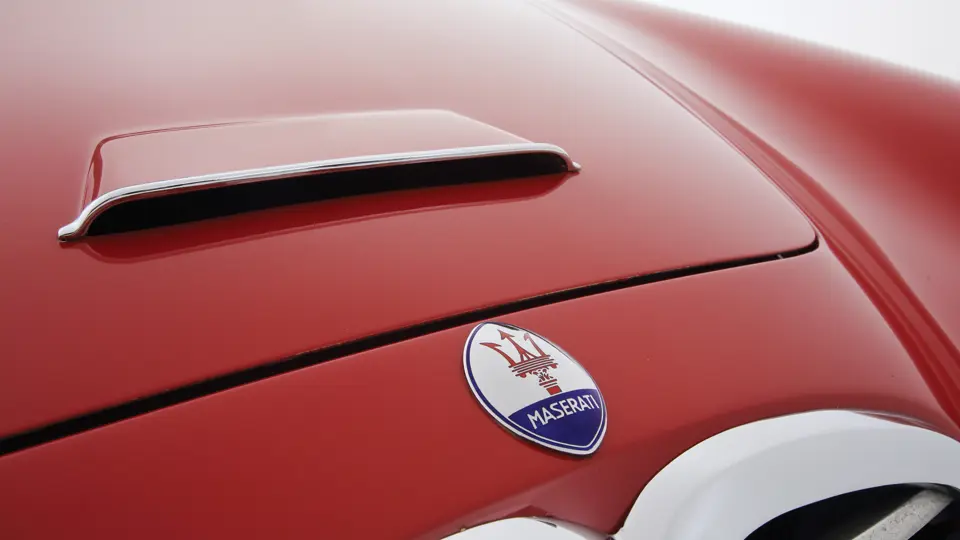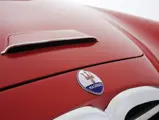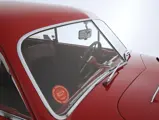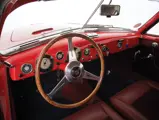
1950 Maserati A6 1500 Turismo by Pinin Farina
{{lr.item.text}}
€308,000 EUR | Sold
{{bidding.lot.reserveStatusFormatted}}
- Rare example of Maserati’s first road car
- One of the final examples built
- Restored by Claudio Zampolli
- Rare exemplaire de la première Maserati de route
- Un des derniers exemplaires produits
- Restaurée par Claudio Zampolli
65 bhp, 1,488 cc inline six-cylinder single overhead-camshaft engine with Weber carburettor, four-speed gearbox, independent front suspension via wishbones and live axle rear suspension, and four-wheel hydraulic brakes. Wheelbase: 2,550 mm
Moteur six-cylindres en ligne, 1 488 cm3, 65 ch, un ACT, carburateur Weber, boîte manuelle quatre rapports, suspension avant indépendante avec triangles, essieu arrière rigide, freins hydrauliques à tambour sur les quatre roues. Empattement: 2 550 mm.
Out of war-torn, late 1940s Italy came a surprising development: racing car builder Maserati, no longer family-owned, began producing road going cars for a high-end clientele. The seven Maserati brothers had dwindled to just three by the time their racing firm was sold to Italian industrialist Commendatore Adolfi Orsi in 1937, but, notably, the remaining trio, composed of siblings Bindo, Ernesto, and Ettore, remained on hand for another decade.
Although it was their name that appeared on the doors to the Orsi-owned workshop in Modena in central Italy, the relationship between the brand’s namesake and its controller had deteriorated by the outbreak of World War II. Despite their grievances with management, Fratelli Maserati nonetheless developed a sophisticated new six-cylinder engine in 1942.
It was also under their guidance that the first road going Maserati was built, the A6 1500 TR (Testa Riportata), which was a test mule. Its nameplate, derived from company founder Alfieri Maserati and its newly developed powertrain, hinted that this would be no mere one-off project. The project was put on hold as war gripped the Italian peninsula; although, the Maserati factory was largely spared the devastation that occurred so prominently elsewhere.
In some ways, the Maserati story seems almost an amalgamation of so many other Italian brands, but in the end, it was Maserati that beat racing rival Ferrari to the punch with its largely Pinin Farina-penned A6. It was more daring and rounded than pre-war Italian designs, as it was crafted from lightweight, and rather scarce in the late 1940s, aluminium, which gave it a light curb weight of about 950 kilograms. Its interior was elegant but not conspicuously sumptuous, as it boasted a full complement of Jaeger gauges, a floor-mounted four-speed gear shift, and a sporty three-spoke steering wheel.
The A6 was a stately touring car, with its ultra-long bonnet hiding a 1,488-cubic centimetre, inline six-cylinder, single overhead-camshaft engine. Most of the original run utilised a single Weber carburettor, but many cars were later retrofitted with a triple setup that added an extra dose of power. The single Weber variant’s 65 brake horsepower figure might sound modest, but the A6 1500 was nonetheless more than adequate for Italy’s roads at the time. In fact, some of the 61 A6 1500s that were built were designed for competition use. At the 1951 Coppa Inter-Europa, an impressive five A6 1500s were entered, which is a testament to the Maserati’s performance credentials. Underneath, the small car used a separate tubular chassis with an independent coil-sprung front suspension and a live axle at the rear. Houdaille hydraulic shock absorbers were also fitted; this was a premium product that indicated the attention to detail afforded to Maserati’s first road car.
After its debut at the 1947 Geneva Motor Show, the grey A6 1500 show car impressed enough buyers that it was put into production shortly thereafter.
The A6 offered here was assembled in 1950, and it is one of the last 10 commissioned. Early records for the shapely touring car have been preserved, offering a glimpse into the formative years of both the A6 1500 and, perhaps more importantly, Maserati as a builder of road cars. In March 1950, this A6 was delivered as a rolling chassis to Carrozzeria Pinin Farina in Turin, a long way from Maserati in Modena. More than three months later, the car’s body was completed. Before the end of 1950, the car was delivered to Maserati’s Rome agency, Gugliemo Dei, but it remained in the firm’s possession until July 1951.
This A6 1500 was first sold to a Mr Catullo del Monte, of Rome, and historical documents from that sale are so precise that they indicate it was fitted with Pirelli Corsa tyres, a Weber 36DCR carburettor, Maserati spark plugs, and a full tool kit.
Del Monte’s ownership of the A6 1500 was short. In 1952, an American living in Rome, Edwin Henry Morris, acquired the car. A few years later, he exported it home to the United States. Whilst its subsequent history in the U.S. has not been thoroughly recorded, the A6 1500 was restored in California by Claudio Zampolli, of V-16 supercar Cizeta fame. Subsequently, the A6 1500 has been gently enjoyed by its current owner, who took it home to Italy to drive it in the 2011 Mille Miglia. It presents well, as it is finished in a shining example of its original red paint, and it shows limited signs of use.
This example of Maserati’s first production car is ready to be both enjoyed and displayed in front of the most discerning judges, and it is bound to garner particular interest given the brand’s recent resurgence in the new car market.
Au lendemain de la guerre, dans l'Italie encore dévastée, se produisit à la fin des années 1940 un événement inattendu : Maserati, constructeur de voitures de course n'appartenant plus à la famille portant son nom, s'est mis à produire des voitures de route pour une clientèle haut de gamme. Les sept frères Maserati n'étaient plus que trois quand leur entreprise a été vendue, en 1937, au Commendatore Adolfo Orsi, industriel italien, mais le trio composé de Bindo, Ernesto et Ettore est resté impliqué pendant encore 10 ans.
Les grilles de l'usine de Modène, appartenant à Orsi, portaient certes leur nom, mais les relations entre les fondateurs de la marque et leur commanditaire se sont détériorées quand la guerre a éclaté. Toutefois, malgré les désaccords avec la direction, les frères Maserati ont tout de même développé en 1942 un nouveau moteur six-cylindres sophistiqué.
C'est aussi avec leurs indications qu'a été construite la première Maserati de route, l'A6 1500 TR (Testa Riportata), une voiture d'essais. Son nom, issu du fondateur de l'entreprise Alfieri Maserati et de son nouveau moteur six-cylindres, laissait supposer qu'il ne s'agissait pas d'un modèle unique. Le projet était toutefois mis en sommeil quand la guerre s'est étendue sur la péninsule italienne ; l'usine Maserati était cependant largement épargnée par les bombardements qui détruisaient une partie des équipements du pays.
D'une certaine façon, l'histoire de Maserati est comme un amalgame de celles d'un grand nombre d'autres marques italiennes mais, au bout du compte, c'est Maserati qui a coiffé au poteau son rival Ferrari avec son coupé A6 dessiné par Pinin Farina. Il était plus audacieux que les voitures italiennes d'avant-guerre et sa carrosserie était formée en aluminium, métal rare à la fin des années 1940, ce qui permettait à son poids de ne pas dépasser 950 kg. Son habitacle était élégant sans être ostentatoire et il présentait un ensemble complet d'instruments Jaeger, un levier de vitesses au plancher pour commander une boîte quatre rapports, et un volant sport à trois branches.
L'A6 était une voiture de Grand Tourisme qui en imposait, avec son long capot dissimulant un moteur six-cylindres de 1 488 cm3, doté d'un arbre à cames en tête. Les plupart des modèles comportaient un carburateur Weber, mais de nombreux exemplaires furent par la suite équipés d'un montage à trois carburateurs, ce qui apportait un surcroît de puissance. Celle de la version à un seul carburateur s'élevait à 65 ch, ce qui peut paraître modeste mais qui n'empêchait pas l'A6 1500 d'être à l'époque parfaitement à l'aise sur le réseau routier italien. En fait, quelques-uns des 61 exemplaires d'A6 1500 furent réalisés pour la compétition. Dans la Coupe Inter-Europa 1951, pas moins de cinq A6 1500 ont été engagées, ce qui témoigne du potentiel de performances de ces Maserati. Au niveau structure, la voiture disposait d'un châssis tubulaire avec une suspension avant indépendante dotée de ressorts hélicoïdaux et un essieu arrière rigide, des amortisseurs Houdaille hydrauliques complétant le tout : ce produit de qualité supérieure traduisait l'attention que portait Maserati aux détails de sa première voiture de route.
Après sa présentation au Salon de Genève 1947, le prototype d'A6 1500 impressionnait un nombre suffisant d'acheteurs pour qu'une petite série soit lancée.
L'A6 proposée ici a été assemblée en 1950 et c'est une des 10 dernières produites. Des archives concernant ce modèle ont été conservées, ce qui permet d'avoir une idée de ces premières années de l'A6 1500 et, peut-être plus important encore, de la façon de faire de Maserati comme constructeur de voitures de route. En mars 1950, cette A6 était livrée en châssis roulant à la Carrozzeria Pinin Farina, à Turin, loin de l'usine Maserati de Modène. Plus de trois mois plus tard, la carrosserie était terminée. Avant la fin de 1950, la voiture était livrée à l'agence Maserati de Rome, chez Gugliemo Dei, où elle restait jusqu'en juillet 1951.
Cette A6 1500 était ensuite vendue neuve à un M. Catullo del Monte, de Rome, et les documents historiques concernant cette transaction sont si précis qu'ils indiquent que la voiture était équipée de pneus Pirelli Corsa, d'un carburateur Weber 36DCR, de bougies Maserati et d'une trousse à outils complète.
Del Monte n'a pas gardé la voiture très longtemps. En 1952, un Américain vivant à Rome, Edwin Henry Morris, en faisait l'acquisition. Quelques années plus tard, il l'exportait chez lui aux États-Unis. L'histoire de cette A6 1500 dans ce pays n'a pas été enregistrée dans le détail, mais elle a été restaurée en Californie par Claudio Zampolli, célèbre par la supercar Cizeta V-16. Par la suite, elle a été utilisée avec plaisir par son propriétaire actuel, qui l'a transportée en Italie en 2011 pour prendre part aux Mille Miglia. Elle offre une belle présentation, avec une peinture de qualité dans sa teinte rouge d'origine, et elle ne montre que de discrets signes d'usure.
Cet exemplaire de la première Maserati de série est prêt à être utilisé ou exposé devant les juges les plus perspicaces. Il attirera forcément un intérêt particulier, compte tenu du récent renouveau de la marque sur le marché actuel.






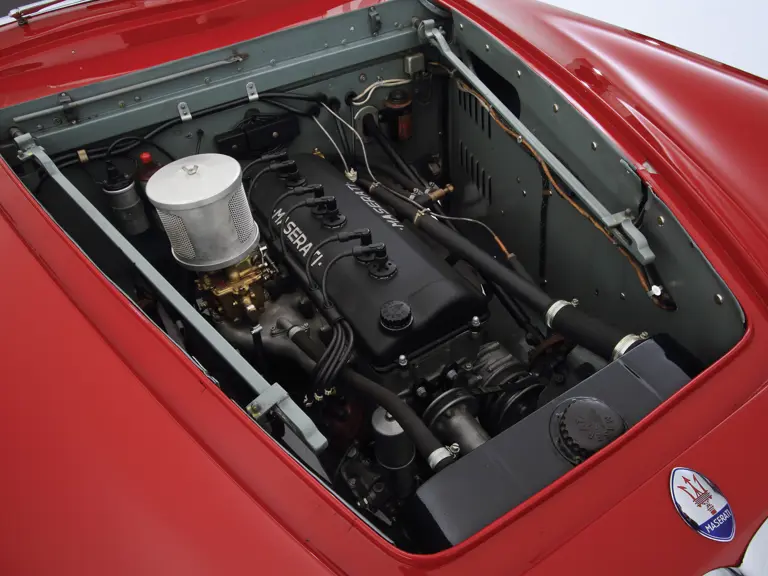








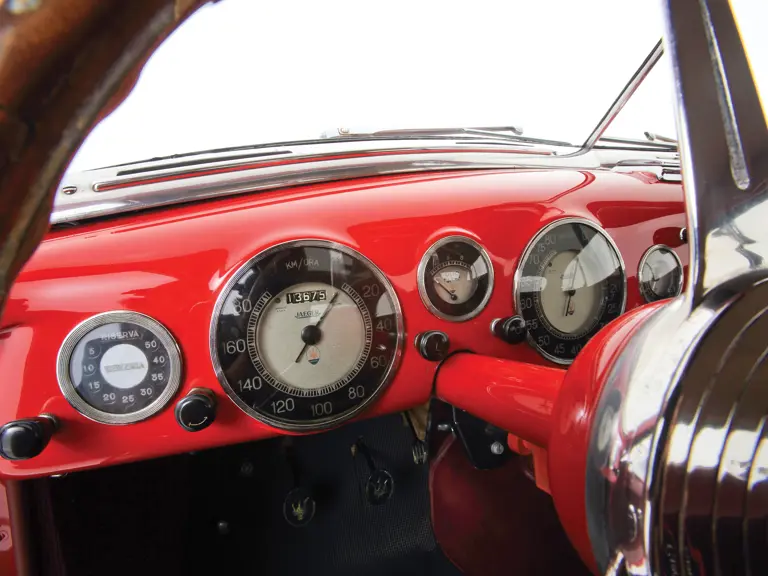








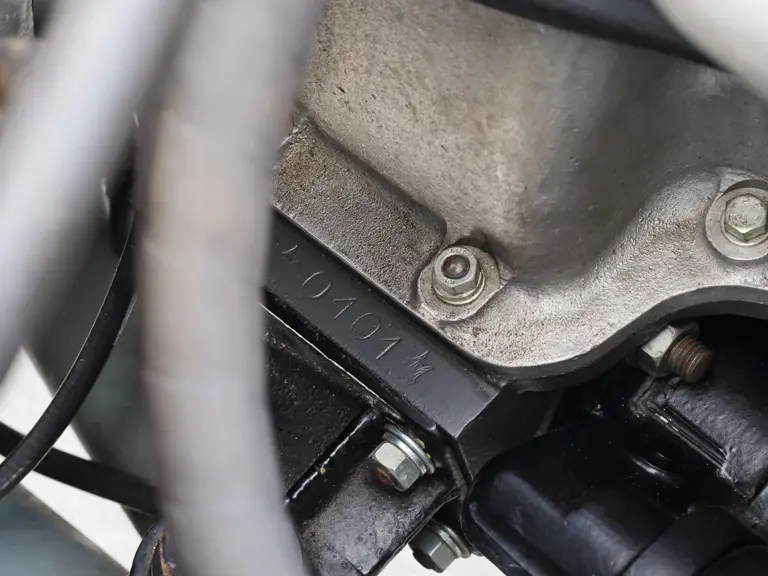
 | Monte Carlo, Monaco
| Monte Carlo, Monaco

